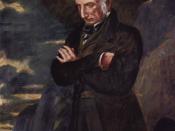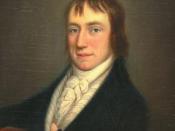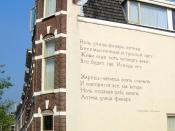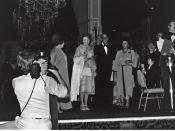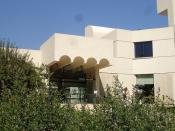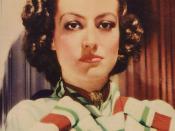A STYLISTIC ANALYSIS OF WILLIAM
SHAKESPEARE'S POEM "WINTER"
Linguistic studies have taken such rapid strides in recent years that the range is baffling
to the innocent and amazingly delightful to the linguistics-oriented. Applied linguistics is
concerned with many fields and subjects on Planet Earth and possibly beyond that.
A piece of literature largely depends on thought and style. The concept of style in
literature is the product of abstraction in the sense that style is based on a special and
unique use of language. It is just one quality contained in any piece of writing. The style
of a novel, a play, an essay or a poem is only one part of its totality.
The study of style has been in use in German, French and English since the early 19th
century. In the early sixties of the 20th century M.A.K.Halliday introduced the term
'linguistic stylistics'. The main concern of descriptive linguistics is the systematic study of
that part of human behavior called language.
William Wordsworth in Lyrical Ballads (1798) suggested that poetry should deal with the
experience of those living close to Nature, especially in the country. It could be "the
language of conversation in the middle and lower classes of society.. "
Long before the Poet of Nature came on the scene, Shakespeare brought the language
close to those who dwelt in the country. Hence my selection of this particular poem.
Keeping in mind all these concepts we can attempt a lexical analysis of the poem
composed in the inimitable style of Shakespeare.
Text of the poem : Winter
'When icicles hang by the wall,
And Dick the shepherd blows the nail,
And Tom bears logs into the hall,
And milk comes frozen home in pail
When blood is nipt and ways be foul,
Then nightly sings the staring owl
Tuwhoo!
Tuwhit, tuwhoo! A merry note!
While greasy Joan doth keel the pot,
When all around the wind doth blow,
And coughing drowns the parson's saw,
And birds sit brooding in the snow,
And Marian's nose looks red and raw,
When roasted crabs hiss in the bowl
Then nightly sings the staring owl
Tuwhoo !
Tuwhit ! tuwhoo! A merry note!
While greasy Joan doth keel the pot'.
The poem begins with adverb of time "when" and goes on to use 'when', 'then' and
'while', a total of light occurrences. These adverbs render the idea of time and space to the
narration. The place is evidently a cottage in the country.
Shakespeare the dramatist provides an interesting dramatic touch with the appearance of
characters within and outside the humble house. Dick the shepherd, Tom (must be the
son), Joan (of course the wife), parson and Marian. Birds, crabs and the owl complete the
picture.
Nominals used for winter:
Icicles Snow Wind
A typical pastoral cottage is described with special register words :
Wall milk Nail pail Hall bowl Logs pot Greasy roasted
Language activity is related to each character:
'Dick the shepherd blows his nail'
'Tom bears logs into the house'
'Greasy Joan doth keel the pot '
The coughing parson'
Marian with a nose red and raw with cold.
In addition to human beings the poet uses the language to
bring into focus other creatures like 'roasted crabs'. Even the owl and the birds are
engaged in their appointed language activity.
'And birds sit brooding in the snow' 'Then nightly sings the staring owl'
'Brooding birds' and 'sings the staring owl' are alliterative as well as unusual collocations.
The poet attributes human situations like 'brooding' and 'staring' to feathered creatures.
More unusual collocations:
'greasy Joan'
'roasted crabs hissing'
Pots and pans can be greasy but here 'greasy Joan' is a picturesque presentation. Can
crabs hiss in the bowl? But it is the poet's prerogative to assign any action to anyone by
keeping his inventions under the spell of his language, and without offering any reason!
There is a great variety of lexical items in such a short poem. Persons, objects, seasons
and surroundings have been artistically blended with words and phrases. The attention of
the reader is drawn with appreciation to colorful images, epithets, suitable register words
and other poetic devices.
Irony as a poetic device is used in 'merry note' while the song of the owl in such
an atmosphere can hardly be merry !
There is no dearth of sounds in the poem. We find a wealth of phonological material here.
But we will not go into details as this analysis is mainly confined to lexical items.
Sounds: coughing hissing tuwhoo tuhoo
In this peaceful though freezing domestic scene creeps in a touch of horror associated
with the dark night.
'When blood is nipt, and ways be foul': We know the 'foul ways' are most likely to create
terror into such cold, damp, dark and dreary nights. One is reminded of witches in
Macbeth with their cries of 'fair is foul'.
Nine descriptive epithets, five 'winter nominals and a number of unusual collocations,
pictorial phrases,
refrains and repetitions enrich the poem with a rare beauty.
'Greasy Joan keels the pot is used twice and can be taken as the summative phrase of this
poem about a peaceful, eco-fuendly household. A loving family sustained with care,
cooperation and unlimited love with the parson's saw and Marian's red and raw nose
complete the rural picture.
With such control, mystery and magic of language Shakespeare is rightly recognized not
only as the immortal Bard of Avon but also the Bard of the whole world.
REFERENCES
Carter, Ronald, ed. 1982. Language and literature: An introductory reader in stylistics.
London: Allen and Unwin.
Chapman, Raymond. 1973. Linguistics and literature: An
introduction to literary stylistics. London: Amold.
Fowler, Roger, ed. 1966. Essays on style and language.
London: Routledge.
Fowler, Roger. 1986. Studying literature as language. In Theo
D'haen, ed. 1986. Linguistics and the study of literature.
Amsterdam: Rodopl.
Freeman, Donald C., ed. 1970. Linguistics and literary style.
New York: Holt, Rinehart and Winston, Inc.
Halliday, M.A.K. 1970. Descriptive linguistics in literary
studies. In Freeman 1970.
Halliday, M.A.K., and Ruqaiya Hasan. 1976. Cohesion in
English. London: Longman.
